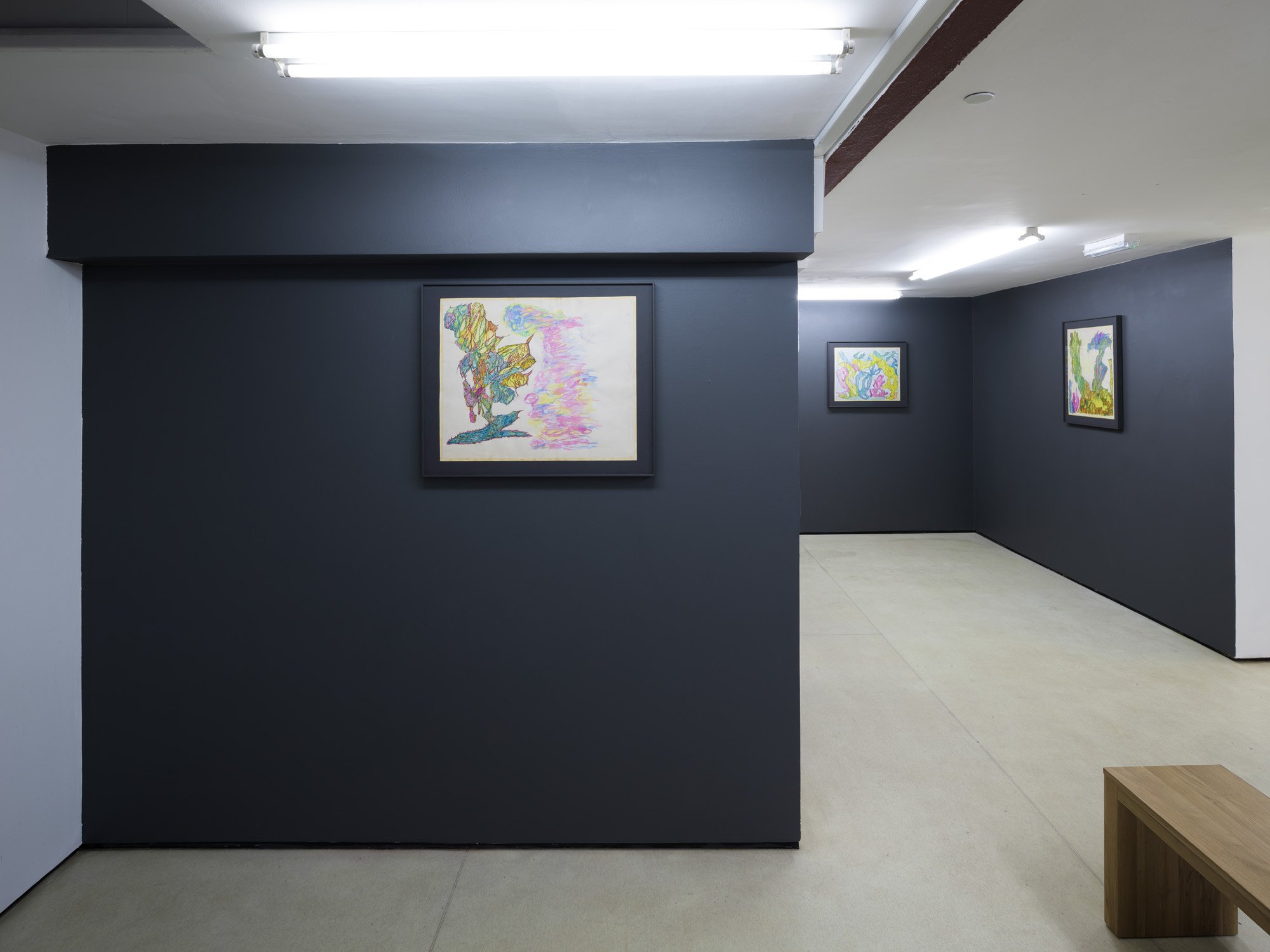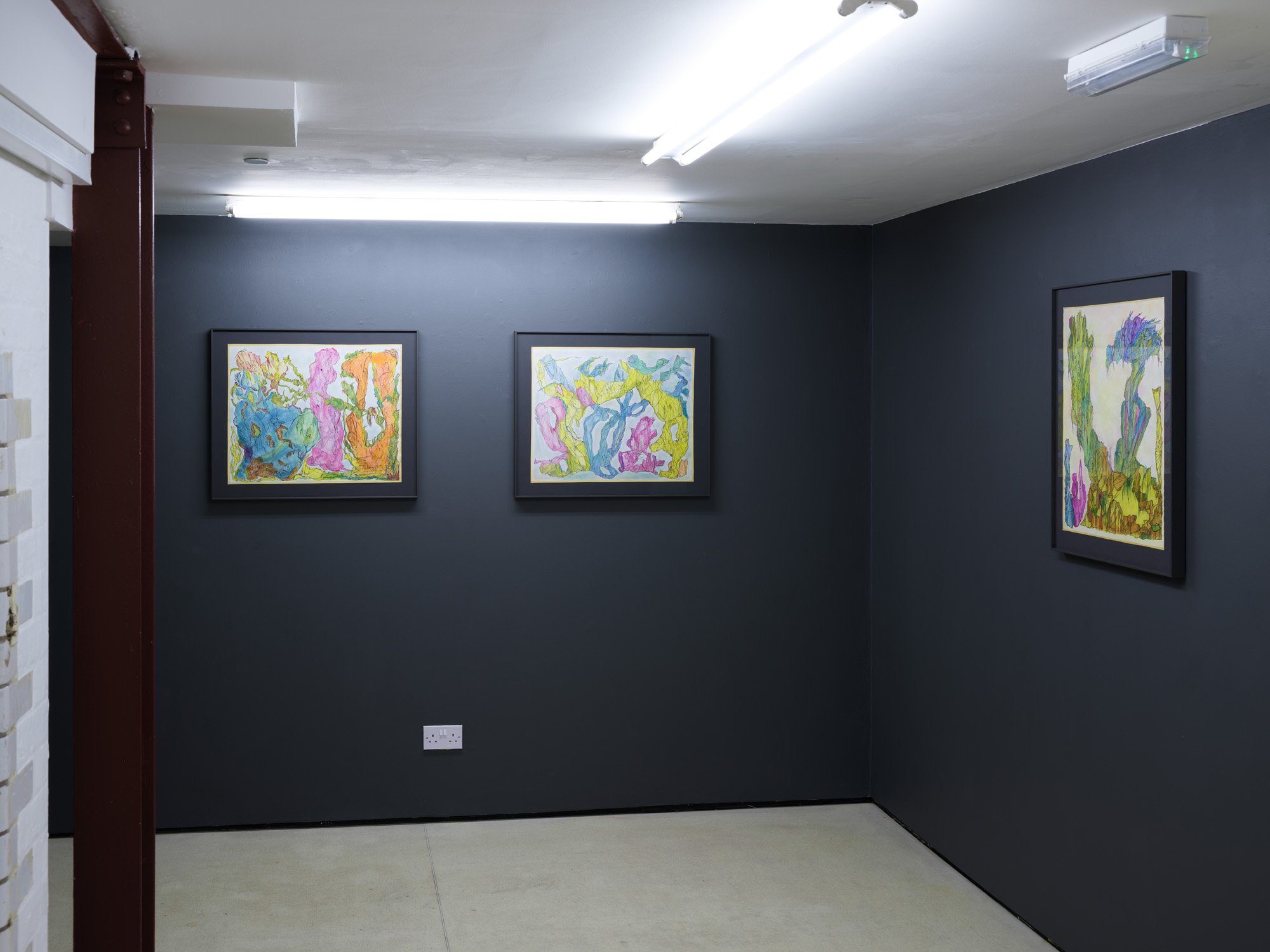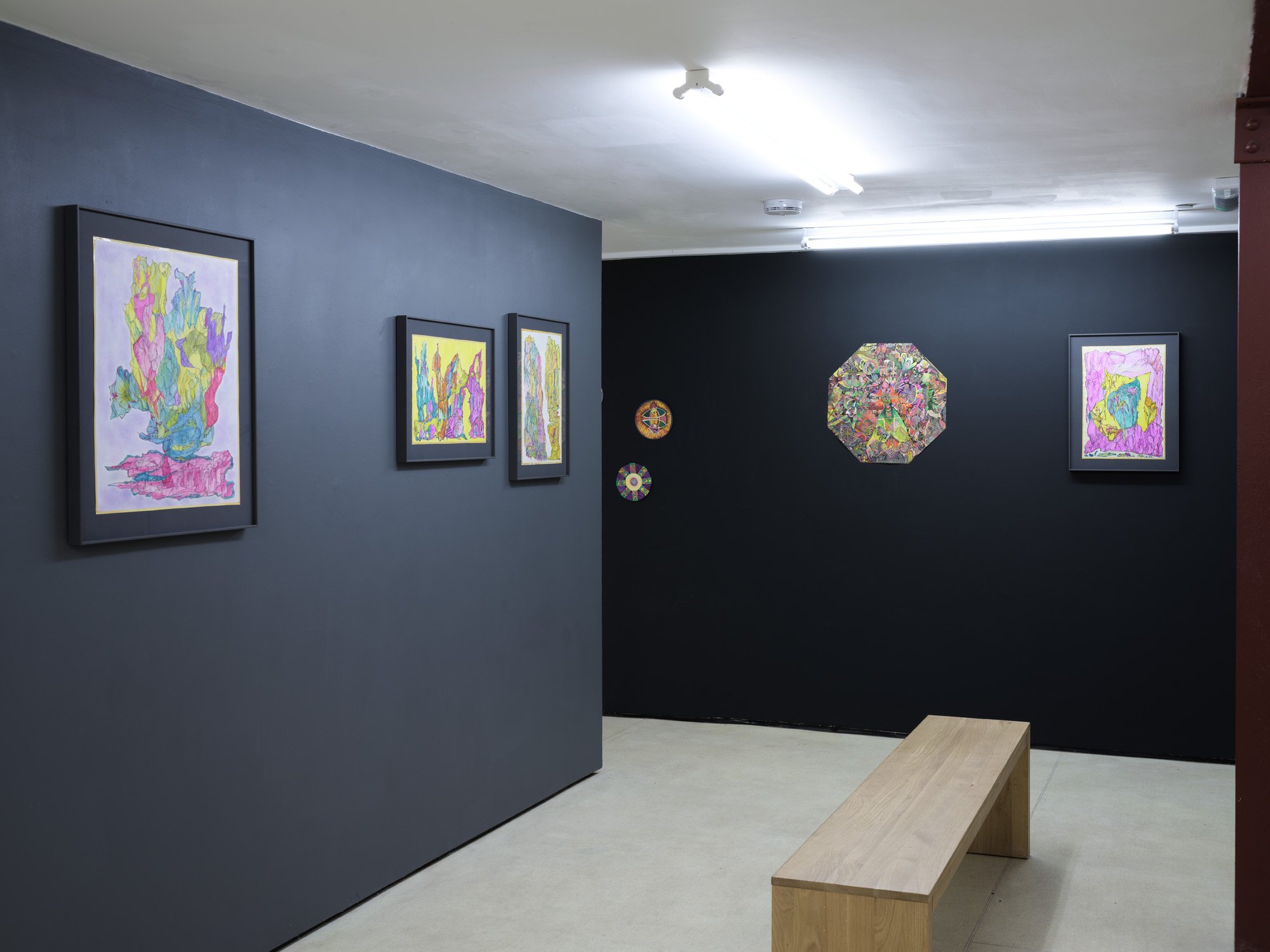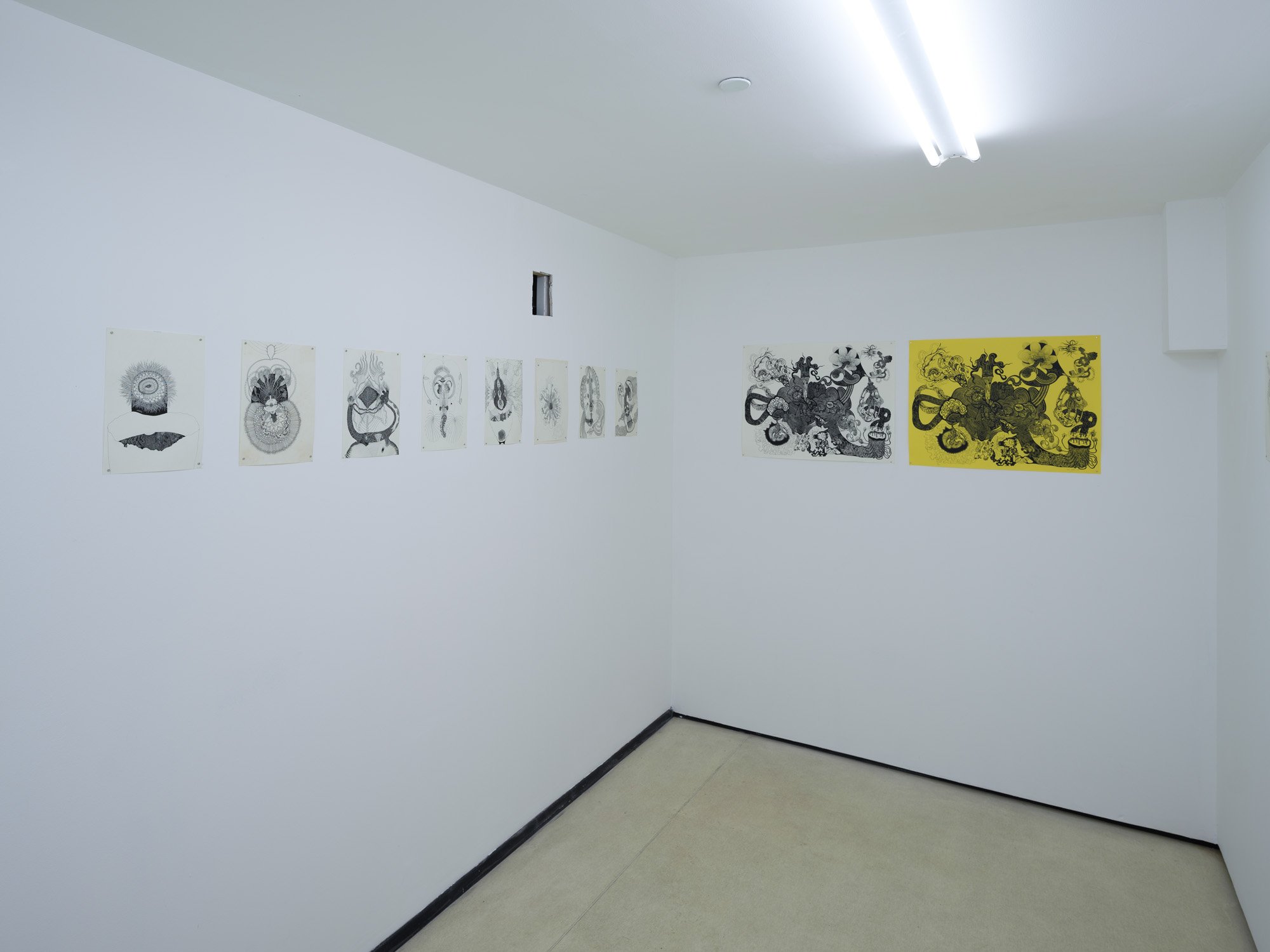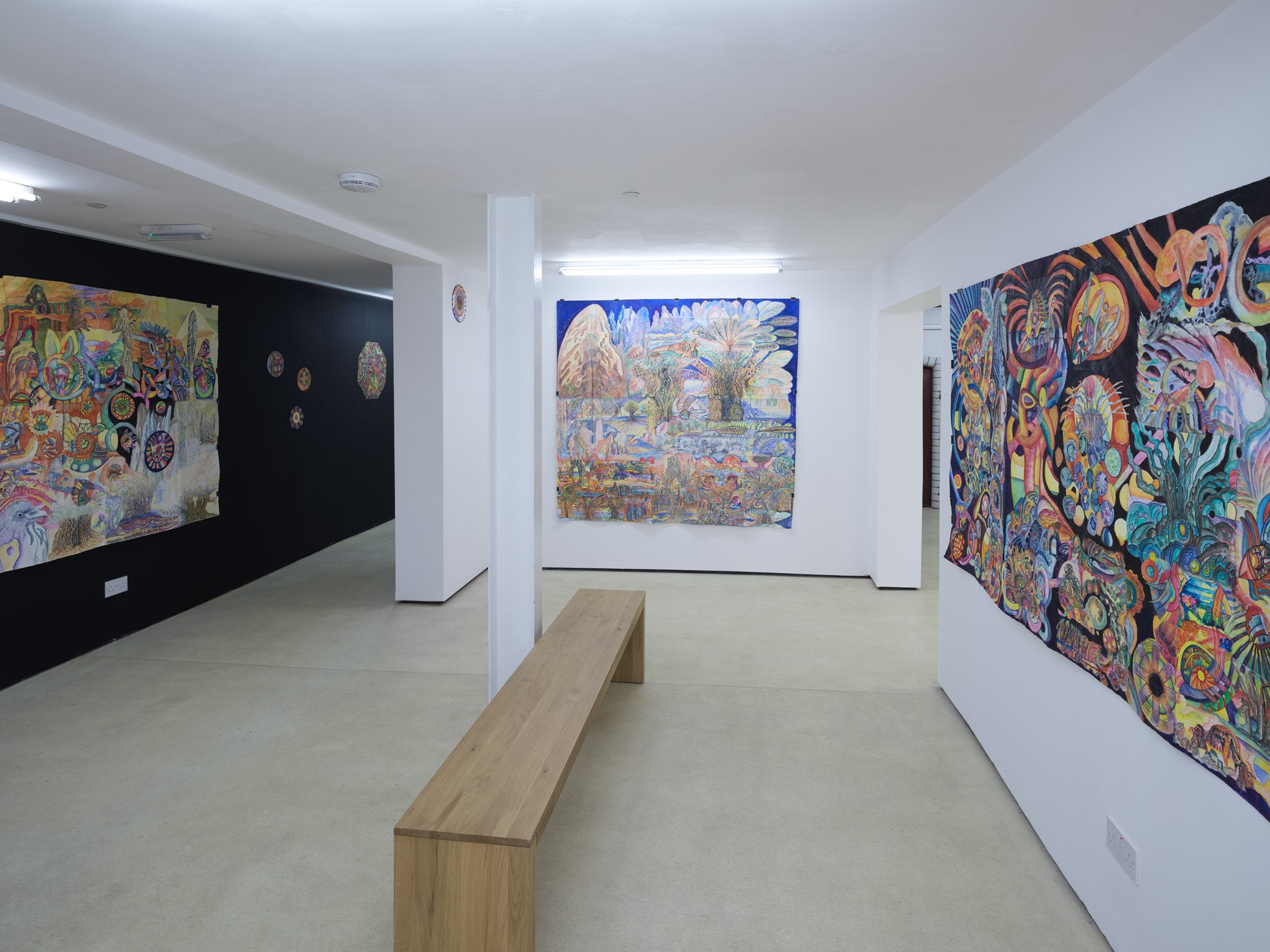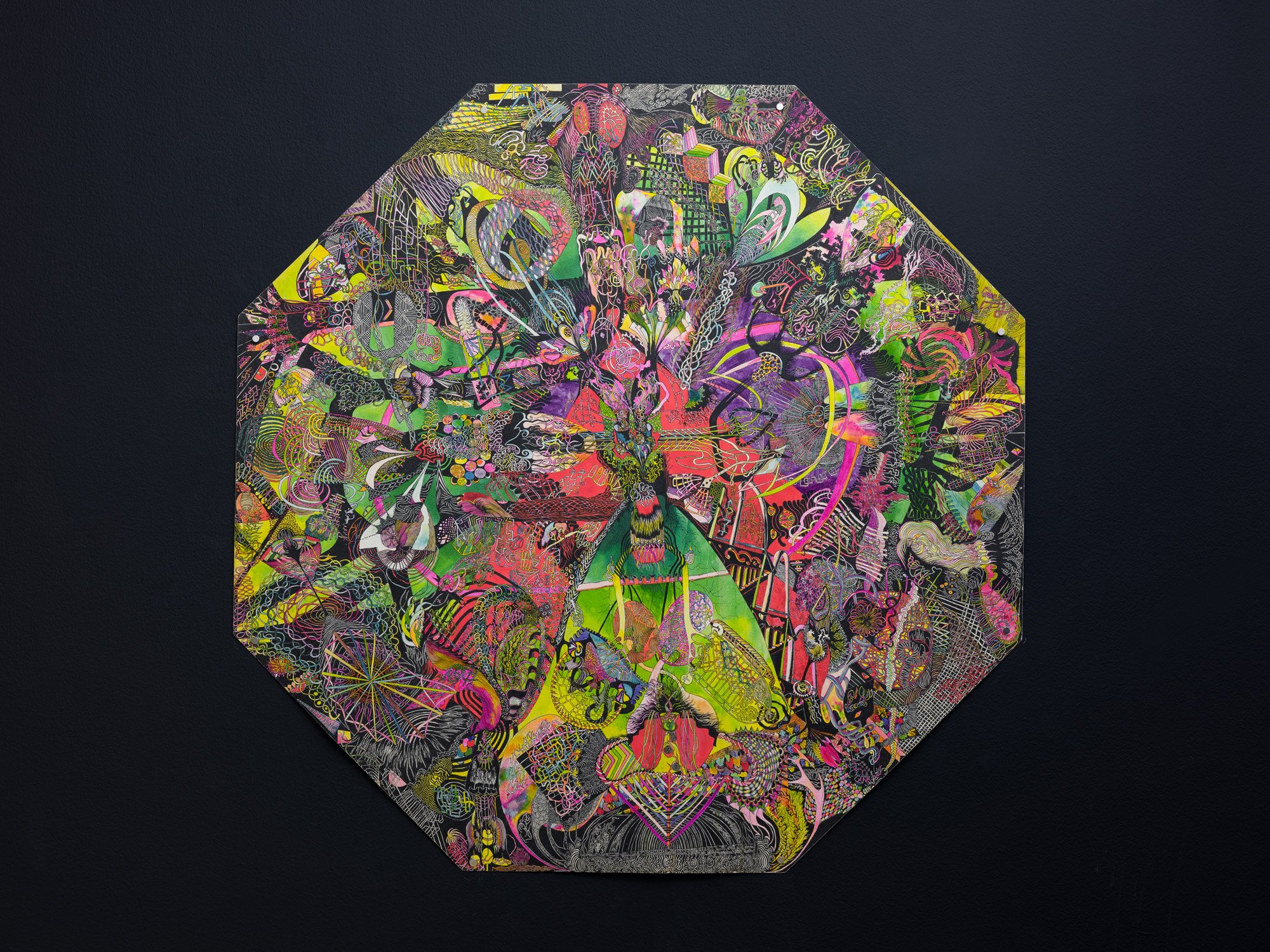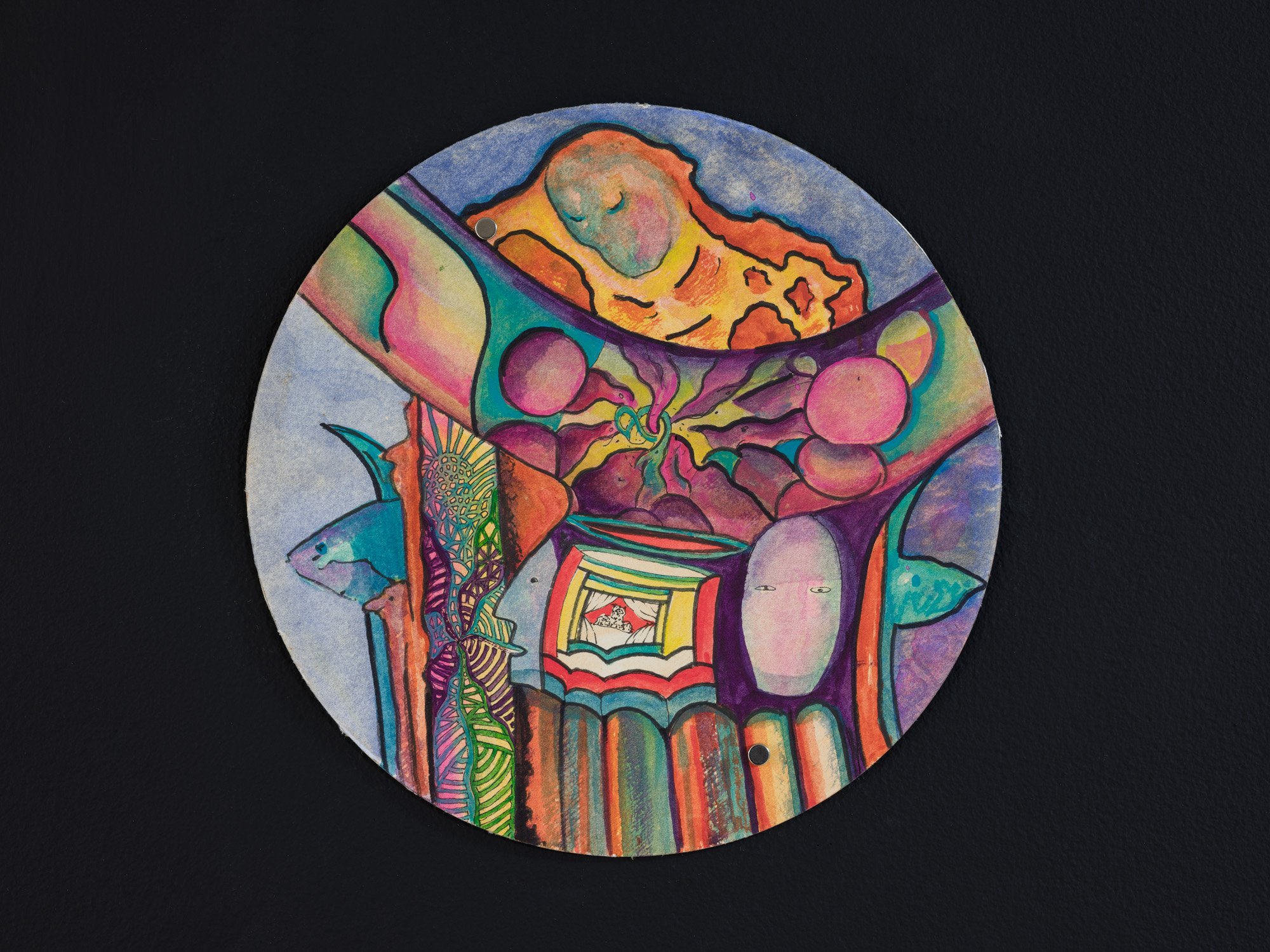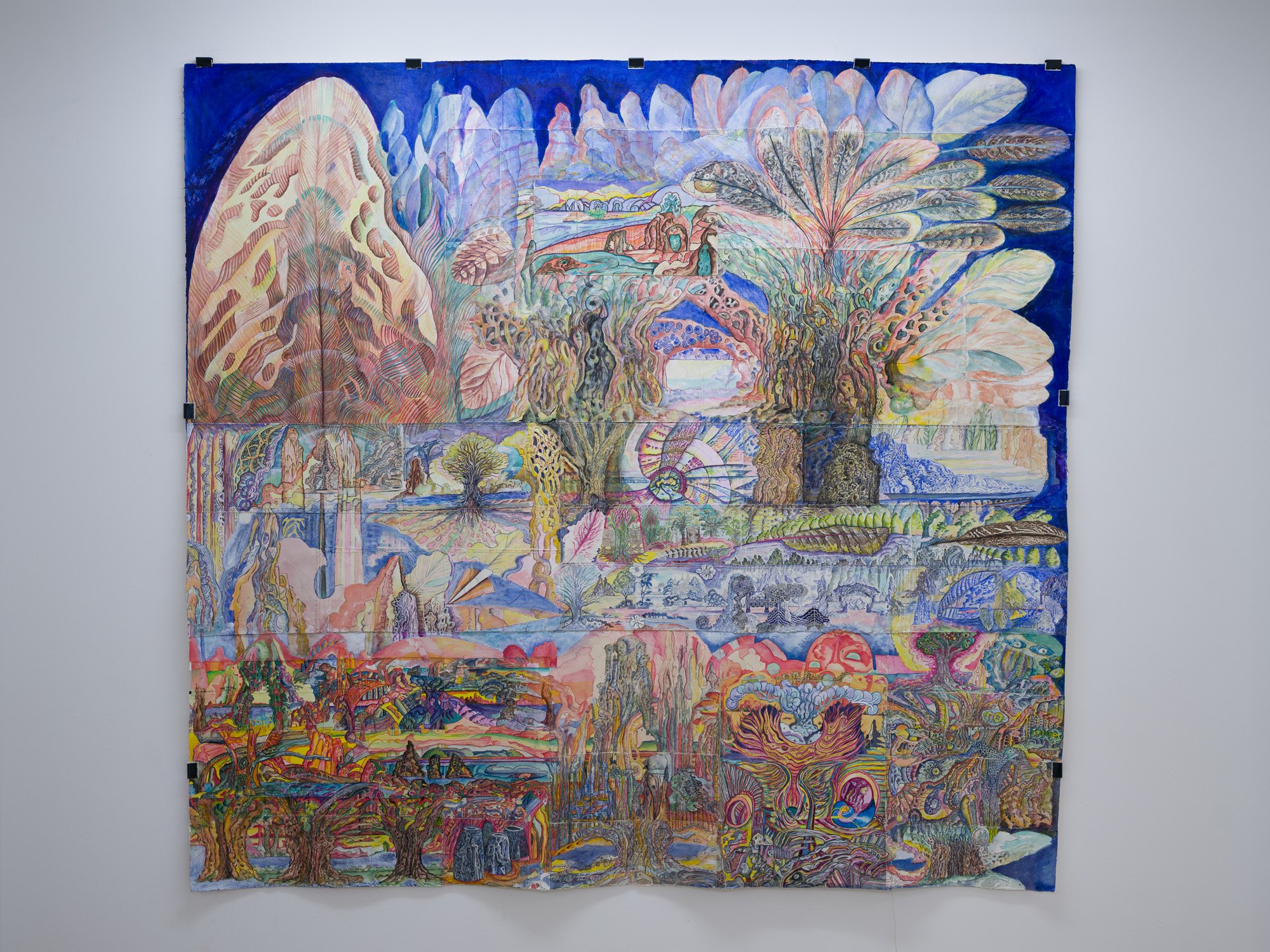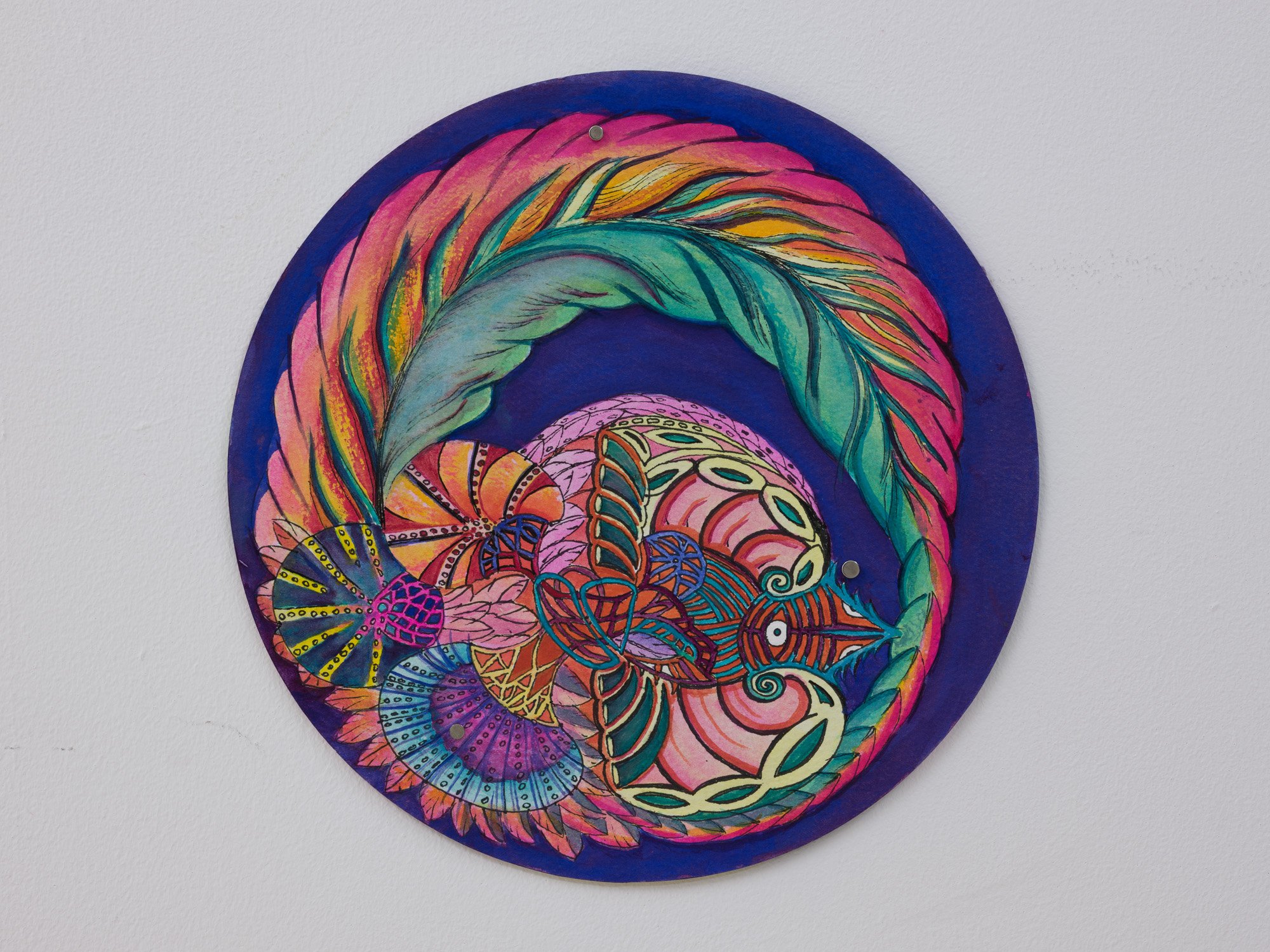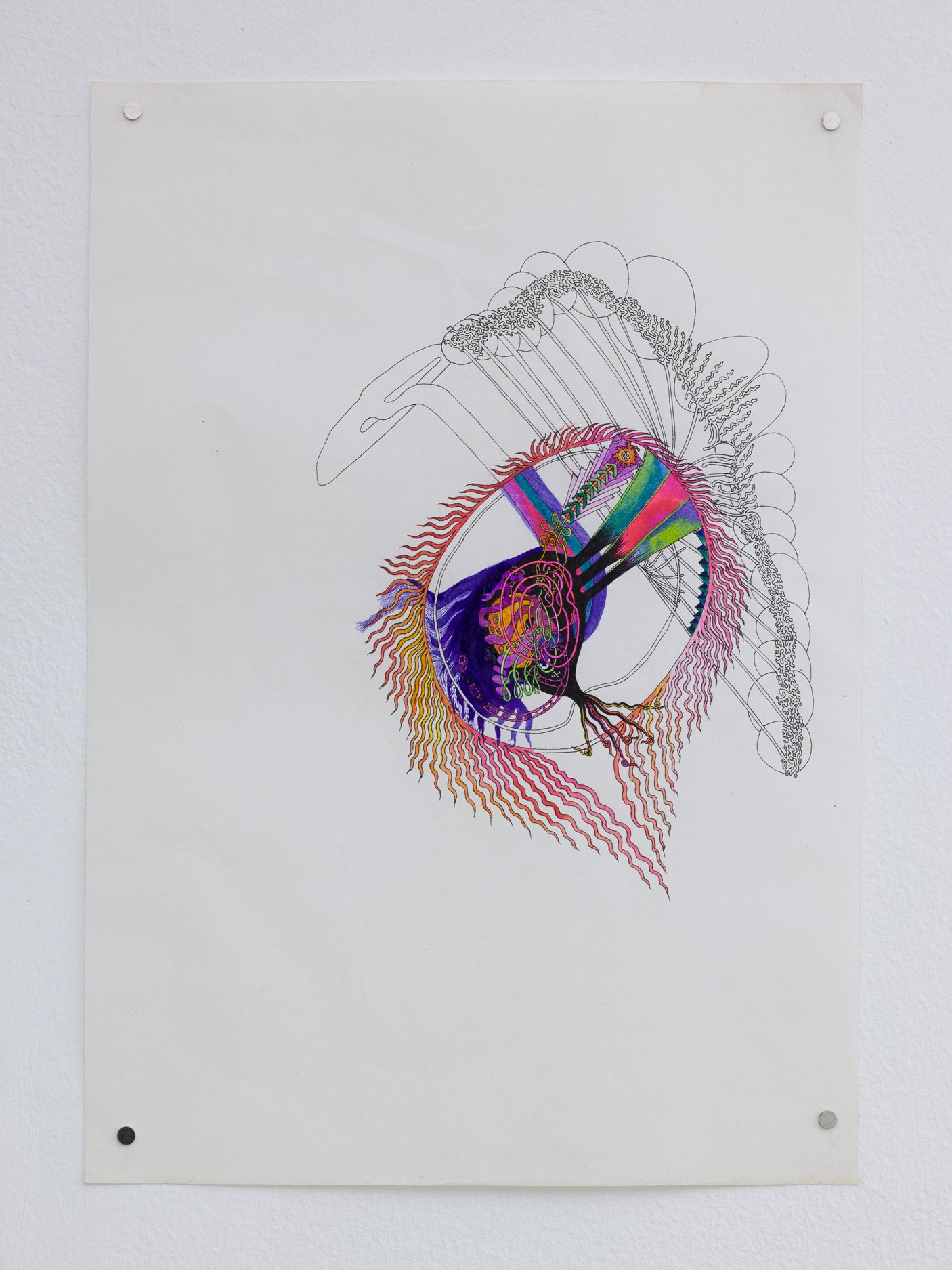GRATITUDENOUSLY
Ann Churchill & Judith Churchill
28 January – 5 March 2023
GRATITUDENOUSLY is an exhibition of works by Judith Churchill and Ann Churchill
organised by Elizabeth Neilson (Judith’s granddaughter and Ann’s daughter).
It includes works by two generations of the same family who would not define themselves as
artists, but who both used drawing as a tool to document their own inner journey. In their
abstract diaristic drawings from the 1960s and 70s, they recorded life in a supernatural,
unconscious manner. In Ann’s more recent large-scale scroll works, forms are repeated
across expansive, abstracted comic strips. Ann is interested in how the term ‘doodle’ is
derided or understood negatively: to her, doodles are a way to express the personal
unconscious imagery that we all have within us.
JUDITH CHURCHILL (b. 1916, Woollahra, Australia; d. 1998, London, UK) did not exhibit
her work during her lifetime. She worked as a delivery driver for Osram and was the first
woman to receive beer money as a unionised driver. During the Second World War she
drove ambulances, and later in life she worked as a preschool nursery assistant. She was
married and had three children. She and her family lived in a rented flat above a newsagent
off Kensington High Street, London, from the 1930s until her death in 1998. Judith’s practice
was one of exploration and healing. She most often produced work when she was
experiencing a mental health challenge.
ANN CHURCHILL (b. 1944, Oxford) is a self-taught maker whose output encompasses
drawing, painting, knitting, batik and beading. Churchill views her practice as a meditative
process that supports her own inner spiritual journey. Her work has been included in a
Hayward Gallery Touring Exhibition: Not Without My Ghosts: The Artist As Medium, Drawing
Room, London (2020); touring to: Grundy Art Gallery, Blackpool (2021), Glynn Vivian Art
Gallery, Swansea (2022), Millennium Gallery, Sheffield (2022). Her solo exhibitions include
Ann Churchill: Works on Paper: 1974–78 (online), Richard Saltoun Gallery, London (2019)
and Ann Churchill, GRANDINE, London (2018), organised in collaboration with Gaia
Fugazza.
This exhibition has been brought together by Ann’s daughter and Judith’s granddaughter,
Elizabeth Neilson, director of the Zabludowicz Collection and the Pangaea Sculptors’
Centre.
Commissioned essay by Jacqui McIntosh
‘Learning to use our power has been my quest really. Drawing and painting and making. I’m a compulsive person. You put me anywhere and I start to do something.’
Ann Churchill, 2020
The creative output of Ann Churchill (b. 1944) spans over fifty years. This incredible, ongoing body of work, encompassing drawing, painting, beading, knitting and more has, until recently, been largely unseen beyond family and friends. However, through Churchill’s inclusion in recent shows such as the Hayward Gallery Touring exhibition Not Without My Ghosts: The Artist as Medium (2020–22) and her newest exhibition at Quench Gallery in Margate (2023), her extraordinary work is finally finding the audience it deserves. This newfound recognition comes at a time of increased interest in the work and lives of artists such as Hilma af Klint (1862–1944), Georgiana Houghton (1814–84), Madge Gill (1882–1961) and Ithell Colquhoun (1906–88) – artists who were either completely unknown during their lifetime or who sat at the fringes of an art historical canon not quite ready to embrace their esoteric and spiritual vision. Like Churchill, these were women who placed automatism at the centre of their practices and whose spiritual and artistic development was intertwined. Churchill’s exhibition at Quench, shown alongside drawings by her late mother Judith Churchill (1916–98), will be the largest exhibition of her work to date, spanning drawings from the mid-1970s to her most recent large-scale watercolours on paper.
Churchill has always been reluctant to define herself as an artist, preferring to call herself a craftsperson or ‘meditator-maker’. Meditating daily – to calm the analytical conscious mind and access the unconscious – has been key to her practice since the late 1960s. A self-taught artist, Churchill declined a place at Chelsea College of Art when she was fifteen, understanding even then that her way of working might not fit within the conventions of an art college training. Instead, she invented what she has termed the ‘invisible university’ – a way of learning through making and experience and, as Churchill has described, of ‘not being told’.
To Churchill, life and making have always been interconnected, and she firmly believes that ‘if you can pull what makes you most excited and engaged into your everyday life, you enrich it and make it have more meaning’. Her early black and white ‘daily drawings’, drawn using the finest-tipped Rotring ink pens, were made in the short hours whilst her youngest child napped. As her children absorbed more and more of her time, she worked on larger ink pieces that she could stop and start when she had moments to herself. Some of these works, made from the mid-1970s onwards, are on show at Quench. Full of vibrant colour, these intensely worked pieces are endlessly fascinating to view, filled with passage after passage of intricate, labyrinthine and abstracted patterns. Like the virtuosic whiplash line created by Aubrey Beardsley (1872–98), Churchill’s drawing weaves and coils, following an energetic flow which takes the eye from form to form. These incredible works on paper were made without planning or preparatory drawing, emerging instead from the subtle interplay between the hand and the unconscious mind.
Churchill has cited artists such as Beardsley, Scottie Wilson (1891–1972) and Wassily Kandinsky (1866–1944) amongst those that she has been most inspired by. Her childhood, in post-war London, was culturally rich, and she was exposed to many alternative ways of thinking and living. As a child she attended the pioneering Margaret Morris Movement dance school, where she was encouraged to play and paint with primary colours after her lessons – an experience that Churchill credits as the beginning of her relationship with making. Her most important influence, however, was her father, the artist George Churchill (1910-2001), who she has described as someone who ‘lived in the unconscious, in the other’. Through him, she was exposed to the possibilities of automatism and the importance of connecting to the unconscious whilst making.
When her mother Judith was hospitalised due to a devastating mental and physical breakdown in the late 1960s, Churchill’s father encouraged Judith to draw. These extraordinary series of automatic drawings, exhibited for the first time at Quench, show worlds filled with delicate weblike forms that connect by arches and rocky openings, building like layers of geological strata. Judith’s drawings, coloured with vibrant pinks, yellows and turquoises, display the creativity of the unconscious mind – but also a hope in its potential to heal.
Just over ten years ago, Ann embarked on a new way of making and taught herself to paint with watercolour. These enormous works on paper (the largest of which is almost 4 metres wide) differ from her earlier abstract pieces. They display immense, invented landscapes with skies that merge into land and rivers, building layer upon layer of worldly realms, connected by energetic forces. Constructed from scores of smaller paintings and stitched together using linen thread, Churchill works without a plan, making automatically and following where her intuition takes her. Later, when her works are laid out and pieced together, she finds an energetic rhythm that connects them – an instinctive, synchronistic process that she’s described as akin to ‘creating order from chaos’. Her landscapes are populated by ancient trees with knotted, gnarled trunks, their roots descending into dense subterranean worlds whilst branches reach upwards, feathers emerging where leaves should be. The feather is an important motif in her work and one that she associates with the Raven, her medicine animal - symbolically a bird that is a carrier of magic between groups. The figures and outlines of animals appear too, emerging from the trunks of trees, whilst snake like creatures curl around her invented coastlines.
During the first national lockdown in 2020, circles began to appear more frequently within Churchill’s work. She has long been interested in the ancient form of the mandala, a symbol that the psychoanalyst Carl Jung (1875–1961), who drew mandalas daily, once described as ‘a living conception of the self’. She was also drawn to stories about circular, spiral writings made by the artist and occult magician Austin Osman Spare (1886–1956), written perhaps as spells or as a way of releasing energy and emotions for others. Churchill’s circular works appear as both singular pieces and recurring motifs. In one large-scale work, circles, filled with abstract forms and patterns, cluster around seven standing stones or ‘rock goddesses’. For Churchill, these circles represent the departing souls of those lost during the pandemic. Their outlined forms appear at times to merge into the background, her work suggesting that their life force is not lost but is instead transformed and returned to nature.
Churchill’s focus on the feminine within the natural landscape links her to a lineage of women artists such as radical feminists Monica Sjöö (1938–2005) and Judy Chicago (b. 1939). Her works also resonate strongly with those of the British artist and occultist Ithell Colquhoun (1906–88), whose drawings and paintings often explored her animistic belief in an Earth that is alive - where all living things, including humans, are connected by a vital, energetic spirit and force. Churchill’s goal has always been to visualise the energy and unseen forces that exist between the mind, the body, and the world around us. As viewers, we are invited into her incredible invented worlds, to experience our own place within them.
Jacqui McIntosh, 2023
1. Quote taken from a specially commissioned short film, produced for Drawing Room, made by Finley Mist in
collaboration with Ann Churchill (2020). It is viewable online: https://drawingroom.org.uk/resources/ann-
churchill-studio-talk
2. Ibid.
3. Conversation between the author and Ann Churchill at her home in Bath, Monday 5 December 2022.
4. Quote taken from the short film made by Finley Mist in collaboration with Ann Churchill (2020). See note 1.
5. Conversation between the author and Ann Churchill at her home in Bath, Monday 5 December 2022.
6. Ibid.
7. Jung, Carl (1995), Memories, Dreams and Reflections, Fontana Press, p. 221.
8. A small painted portrait by Spare, which Churchill bought for a shilling at a jumble sale in Kensington when
she was in her early teens, is one of Churchill’s most treasured possessions. Her early meditative practice
incorporated this work: an image of the face in the painting appeared within her mind’s eye - a sign that she
was ready to start making.
9. Conversation between the author and Ann Churchill at her home in Bath, Monday 5 December 2022.
Jacqui McIntosh is a writer, researcher and curator based in London. She has worked at Drawing Room since 2011, where she contributes to the understanding of the medium of drawing through research, curation of exhibitions, writing, exhibitions management and programming of events. Jacqui has a particular interest in artists whose spiritual development has evolved in tandem with their artistic output. Her current independent research areas include mediumistic and automatic drawing practices, and the drawings and works on paper of British artist and occultist Ithell Colquhoun. Jacqui was part of the British Art Network’s Emerging Curators Group (2022). A recipient of a Curatorial Research Grant from the Paul Mellon Centre for Studies in British Art (2023), Jacqui is currently researching the role that drawing has played in feminist activism. This research will result in an exhibition at Drawing Room in early 2024.
J.M. Churchill circa 1938
Ann Churchill circa 1968
A limited-edition Ann Churchill Colouring Book is available to purchase for £12. A
percentage of proceeds will be donated to Hospital Rooms, an arts and mental health
charity that commissions extraordinary artworks for NHS mental health inpatient units across
the UK. Colouring sheets are available free of charge. www.hospital-rooms.com






